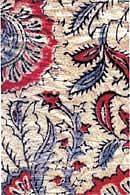Vivid, colourful stories on cloth

The rays from the sun are streaming in from the window behind him and lighting up his work area as he skillfully makes fine lines on cloth. The outlines take shape and gradually unfold as goddess Lakshmi’s figure and a lotus on which she is seated.
He looks up finally and acknowledges our presence. “Now that I have finished this part of my work, I can talk,” he says with a smile. There are indeed several parts to his work, we soon find out. The world-famous Kalamkari work of Srikalahasti involves several painstaking stages of production and requires a high degree of skill and experience.
Kalam means pen in Telugu and kari translates to work, hence this name for the exquisite 3,000-year-old art of painting with pen on cloth. These paintings find expression in scrolls, wall hangings, bedspreads, tablecloths, kurtas, dupattas, kurtis and sarees, all in silk and cotton.
They are also used on bags, desktop objects, stationery items and hordes of décor objects. Besides, strips or large stretches of Kalamkari are picked up by established designers and boutique-owners across India.
Subramaniam explains the various stages of art to us, taking us around his modest home in Srikalahasti near the famous Srikalahasti Temple, which draws lakhs of pilgrims to this small town in southern Andhra Pradesh. There are no retail showrooms or formal schools for the art here. Kalamkari is taught, practised and sold from homes of about 350 artistes like Subramaniam.
Kalamkari, as practised in this town, is an elaborate, laborious and slow process involving several stages — resist-dyeing, sketching and hand painting. Much of this time is taken up by the treatment required on the fabric before and after the painting is completed. The staple colours are red, black, blue and shades of brown including ochre, yellow and mustard. Only thick-woven cloth is used as only this can withstand repeated washing, often in boiling water, that the making entails.
Pochampally and Mangalgiri, the famous weaves of Andhra Pradesh, and raw silk are the popular base materials. Nowadays, Mysore crepe silk, Kanchipuram, Peddapuram and Dharmavaram silks are also used, explains senior artist S Narasimhulu.
These products find their way to big showrooms and boutiques in metros. Individual customers also bring in their fabrics for customised creations. No chemicals are used, which makes this art all the more valuable but a little difficult to maintain. Kalamkari uses vegetable dyes sourced from tree bark, flower and root. Mango bark, myrobalan (karakkai), pomegranate seed or Indian madder root, jaggery and rusted scrap-iron are some of the raw materials. Kalamkari expert, teacher and one of the few Indian craftsmen to have won a Padma Shri (besides several other honours) Jonnalagadda Gurappa Chetty says: “It is no doubt a very painstaking process but the beautiful end result is our reward.”
Kalamkari has another school where art by the same name is made, but using a different process — block printing. It is used in Machilipatnam (aka Bandar) in western Andhra Pradesh. These products are comparatively cheaper.
Kalamkari products were originally created for temples as narrative murals. They narrated stories from epics — the wedding of Rama-Sita and Shiva-Parvati, and Krishna’s exploits were (and still are) popular themes. Being a port, Machilipatnam’s work was heavily influenced and this art acquired more general and nature-inspired motifs under Dutch and later, British rule. Another difference, which is blurring now, at Machilipatnam are the motifs used in the art such as trees, creepers, flowers and animals as well as birds like peacocks and parrots.
Srikalahasti products reveal a greater religious influence considering the town has the eponymous Shiva temple and is close to one of the world’s most-visited temples, Tirupati. To add to it, a plethora of smaller temples in the area. This also explains why many bedspreads and table-cloths were traditionally made in Machilipatnam since they sported ‘non-religious designs’, while the religious motifs of Srikalahasti were considered inappropriate for such purposes, so here, one found more of scrolls and wall hangings.
These non-Hindu elements were used in the art form in the early 20th century when Christian missionaries commissioned artists to do murals based on the life of Christ. Soon, even Persian themes like the famous Tree of Life besides exotic birds and fanciful fish motifs got included. Today, you will see even Egyptian princesses and Chinese-style lanterns and figures on the Kalamkari products of both schools.
Like many traditional Indian crafts, Kalamkari is a family occupation passed on from one generation to another. Therefore, often, you find entire families involved in the business. Despite the products’ high price tags in glitzy showrooms and the increasing interest among fashion designers, artisans here have a modest lifestyle as they lack basic education. They are even exploited by middlemen.
Also, till a few decades ago, Kalamkari was a dying art. This was due to the artisans’ lack of marketing skills and the apathy of the government. The very nature of the art itself — use of vegetable dyes and an intricate, complex process of dyeing which resists mechanisation — also made it difficult to sustain.
Fortunately, a few social workers like Anitha Reddy of Dwaraka are helping these artists improve their living conditions. They have realised that Kalamkari artists are immensely talented and all they require is marketing and financial know-how to help sell their products better.
Deccan Herald is on WhatsApp Channels| Join now for Breaking News & Editor's Picks